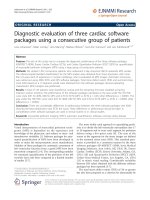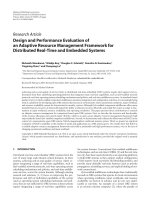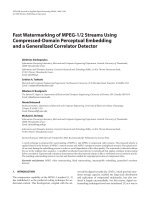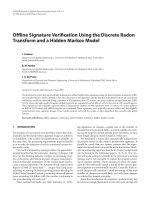Sensory evaluation of value added dairy products using bael pulp (Aegle marmelos) and stevia powder
Bạn đang xem bản rút gọn của tài liệu. Xem và tải ngay bản đầy đủ của tài liệu tại đây (389.86 KB, 10 trang )
Int.J.Curr.Microbiol.App.Sci (2019) 8(9): 2122-2131
International Journal of Current Microbiology and Applied Sciences
ISSN: 2319-7706 Volume 8 Number 09 (2019)
Journal homepage:
Original Research Article
/>
Sensory Evaluation of Value Added Dairy Products using
Bael Pulp (Aegle marmelos) and Stevia Powder
Amarjeet Kaur1*, Anita Kochhar1, Savita Sharma2 and R. S. Boora3
1
Department of Food & Nutrition, College of Home Science, Punjab Agricultural University,
Ludhiana-141004, India
2
Senior Dough Rheologist, Deptt of Food Science and Technology, PAU, Ludhiana, India
3
Horticulturist, Regional Fruit Research Station, Bahadurgarh, Patiala, India
*Corresponding author
ABSTRACT
Keywords
gajrela, burfi, milk,
organoleptic
evaluation, sugar,
stevia, proximate
analysis
Article Info
Accepted:
20 August 2019
Available Online:
10 September 2019
Aegle marmelos also known as bael is being used in traditional medicinal
system since ancient times. This tree belonging to family Rutaceae contains
many phytochemicals making it suitable for use in treatment and prevention
of many common ailments. The chemical compounds isolated from this
fruit are proven to be effective against many non communicable diseseas
like CVDs, diabetes and cancer. Stevia(Stevia rebaudiana) is called honey
leaf in Indian market. It can be easily grown in house gardens, pots or as a
commercial field crop. As the demand of low carbohydrate sweetener is
increasing now a days, Stevia can soon become the King of sweeteners.
Stevia is a natural calorie free product but at the same time it is 300 times
sweeter than sucrose. Considering the benefits of these two plants value
added sweet milk products like gajrela and burfi were prepared using
different proportions of bael pulp and stevia powder and sensory and
proximate analysis of the products were done. Stevia was added to replace
sugar at different levels.
Introduction
Bael (Aegle marmelos) possesses excellent
therapeutic and nutritive value and has high a
potential for processing in to a variety of
quality products (Mandal and Sahoo 2014).
The presence of carotenoids are responsible
for the pale colour of the fruit. The
therapeutically active principle components of
bael fruit include marmelosin, umbelliferone
and skimmianine (Hiremarh et al., 1996).
About 28 volatile compounds are recognized
in the bael pulp, foremost being the
sesquiterpenes and monoterpenes like
2122
Int.J.Curr.Microbiol.App.Sci (2019) 8(9): 2122-2131
limonene, p-Cymene, β-Phellandrene, and
Dihydro-β-Ionone.
These
constituents
contribute to the aroma fruit.
The characteristic bael fruit flavor is due to the
presence of limonene, a key constituent
among these compounds (Charoensiddhi and
Anprung
2008).
Baelpossesses
many
therapeutic properties including antidysentric,
demulcent, astringent, antidiarrhoeal, anti
inflammatory and antipyretic activities. It has
been proved that the constituents purified from
this fruit are biologically active in fighting
against several major diseases like diabetes,
cancer and cardio vascular diseases (Maity et
al., 2009). The growing need for an alternate
source of sugar for control of micro and macro
vascular disorders related with diabetes and
other diseases cannot be ignored. Sugar
substitutes in the form of natural sweeteners
are frequently promoted as healthier and better
options than processed table sugar. Stevia
(Stevia rebaudiana) is commonly used as a
sweet natural sugar (Panchal et al., 2014).
Stevia rebaudiana is a natural sweetest
nutrient rich plant belonging to Asteraceae
family that naturally grows in South America.
procured and checked for any infestation or
damage. The fruit was washed and then
broken by hitting on floor or using a hammer.
The pulp along with seeds and fibres was
scooped out of the fruit with help of a stainless
steel spoon and the peel was discarded. The
scooped out pulp was then weighed and equal
amount of water was added to the pulp. It was
then mixed in a mixer and sieved through a 20
mesh stainless steel to separate the seeds. The
pulp thus obtained was used for the product
development.
The recipe of the product with most
acceptable level of bael pulp and stevia:
Gajrela
Ingredients
Milk
Khoa
Carrots
Bael pulp
Sugar
Stevia powder
-
250ml
10g
80 g
20g
6g
20mg
Method
More than 200 species of stevia are found in
the world but Stevia rebaudiana is the only
species that possesses the characteristic of
sweetening. Stevia leaves contain certain
constituents i.e., glycosides which imparts a
sweet taste but gives no caloric value (Kim et
al., 2002).
Materials and Methods
Procurement
material
and
processing
of
raw
Cleaned and grated the carrots.
Cooked them in milk till it thickened.
Khoa and sugar was added and cooked for 2-3
minutes. Added bael pulp and stevia powder,
mixed well and cooked for 1 minute. The
recipe of the product with most acceptable
level has been given below:
Burfi
Ingredients
The bael fruit (var. Kaghzi), was provided by
Regional Research Station, Patiala, Punjab.
Stevia powder was purchased from Ozzy
Business Consulting Ltd, Patiala. Milk, khoa,
carrots, sugar etc. were purchased from the
local market of Ludhiana. The bael fruit was
Milk
Khoa
Bael pulp
Sugar
Stevia powder
2123
-
500ml
120 g
80g
12g
90mg
Int.J.Curr.Microbiol.App.Sci (2019) 8(9): 2122-2131
Milk was boiled until it thickened.
Khoa and sugar was added and cooked again.
Added bael pulp and stevia and cooked for 2-3
minutes
Set the prepared burfi in a greased plate,
cooled and cut in small pieces.
product with highest overall acceptability was
used as control for second standardization and
stevia was added in four other treatments. The
product thus prepared incorporating bael pulp
and stevia powder was then evaluated for
sensory parameters by semi trained panel and
diabetic panel. The mean scores of different
parameters in control and test recipes with
bael pulp are presented below:
Sensory Evaluation
Gajrela incorporated withbael pulp
The organoleptic evaluation of the developed
value added sweet products was carried out to
select the most acceptable level of bael pulp
from the first trial as well as the acceptable
level of stevia powder in the development of
products in the second trial. In the second trial,
the acceptable product of first trial was used as
the control sample. The sensory evaluation of
the developed products first trial was carried
out by ten trained panelists including faculty
of department of Food and Nutrition of Punjab
Agricultural University while the second trial
was evaluated by both the trained panel as
well as diabetic panel. The panel was provided
with 9 point hedonic scale for attributes like
appearance, colour, texture, flavour, taste and
overall acceptability (Larmond 1970).
Five samples were being prepared including
one control in which only carrots were used as
a base ingredient. The percentage of carrots
was reduced and bael pulp was incorporated at
the 10,20, 30 and 40 percent levels in the
treatments designated as B1, B2, B3 and B4
respectively (Table 5).A significant difference
was observed when evaluated statistically, in
all the sensory parameters including
appearance, colour, texture, flavour, taste and
overall acceptability. The highest scores for
overall acceptability was scored by B2
(7.87)followed by C (7.58) and B1 (7.54). The
overall acceptability decreased as the
percentage of bael pulp was increased. The B2
treatment scored highest in taste i.e., 7.75
followed by B1 (7.6) and C (7.5). The mean
scores of all the parameters of B2 treatment
were observed to be higher i.e., 7.75-8.0 as
compared to C i.e., 7.5-7.7.
Method
Statistical Analysis
The data on organoleptic evaluation and
chemical analysis was analyzed statistically.
Kruskal Wallis test was used for selecting the
best formulations through sensory evaluation.
Results and Discussion
Sensory evaluation of milk based value
added products with bael pulp/powder and
stevia powder.
The sensory evaluation of gajrela and burfi
was carried out to select the most acceptable
proportion of bael pulp in all the products. The
Gajrela incorporated with bael pulp and
stevia powder by semi-trained panel
The difference in scores was found to be
statistically significant with regard to all the
sensory parameters as judged by semi trained
panel. The highest mean scores for different
sensory parameters of Gajrela were observed
for BS2 followed by control (C) and BS1
treatments as shown in Table 6 and Fig.1. The
BS1 and BS2 treatments were comparable to
control (C) treatment for sensory parameters
such as appearance, texture, aroma, taste and
overall acceptability. The test treatments were
2124
Int.J.Curr.Microbiol.App.Sci (2019) 8(9): 2122-2131
significantly different from BS2 treatment in
terms of all sensory parameters. The overall
acceptability scores for theBS2 (7.95)
followed by C (7.59), BS1 (7.37),BS3 (6.94)
and BS4 with a minimum score of
6.63.Vyoma and Kochhar (2008) revealed that
replacing sugar with stevia in preparation of
gajrela scored an overall acceptability score of
7.7 and hence decreasing the calorie intake.
The scores given by the diabetic panel for the
modified recipe with 50mg steviocal was i.e.,
7.7±0.17 and taste scores ranged from
6.9±0.24 to 8.0±0, the highest for the recipe
with 50mg steviocal after the basic recipe
(Aggarwal et al.,2010).
Gajrela incorporated with bael pulp and
stevia powder by diabetics
The overall acceptability scores given by the
diabetics for gajrela prepared by incorporating
20% bael pulp and substituting sugar with
stevia were found to be higher than that of
semi trained panel ranging from 6.7-8.03 as
compared to 6.63-7.95. The statistical analysis
revealed that the sensory scores for all the
sensory parameters namely appearance,
colour, texture, flavor, taste and overall
acceptability were significantly different for
Gajrela incorporated with 20 percent bael
pulp and different levels of stevia powder
(Table 7). BS2 scored the highest scores for
all the sensory parameters with a highest
overall acceptability score of 8.03.It was
followed by BS1 with an overall acceptability
score of 7.54. The control scored a lower score
than both BS1 and BS2 with regards to all the
sensory parameters. The scores for colour
were at par for C and BS3. With respect to
texture, the scores were significantly different
between the treatments and control. The
sensory scores for taste were found to be
statistically significant between the control
and all the treatments, BS1 to BS4.
Burfi incorporated with bael pulp
The control sample was prepared from khoa.
The bael pulp was incorporated at 20, 30,
40and 50 per cent levels assigned as B1,B2,B3
and B4 respectively. Statistical datarevealed
that there is a significant difference between
the most acceptable sample B3 and control
and other test samples in reference to taste and
overall acceptability parameters as shown in
table 8. Other sensory parameters like
appearance, colour, texture and flavour were
found to be of non significant difference in
control and all other treatments. The highest
mean scores for different sensory parameters
of burfi were observed for B3followed by C
and B2 treatments.
However, among the treatments with added
bael pulp, B3 (40 per cent bael pulp) was
selected as control for the standardization of
kheer prepared with different proportions of
stevia powder. The mean score for taste in B3
treatment was highest i.e., 7.95, followed by C
i.e., 7.75.The least score for taste was attained
by treatment with maximum percentage of
bael. Flavour scores for C and B3 were
observed to be at par with each other.
.
Burfi incorporated with bael pulp and
stevia powder by semi-trained panel
The acceptable burfi incorporated with 40 per
cent bael pulpfrom the first standardization
was taken as the Control (C). Further, stevia
powder was added to the rest of the treatments
at 20, 40, 60 and 80per cent levels and was
coded as BS1, BS2, BS3 and BS4 treatments
respectively.
2125
Int.J.Curr.Microbiol.App.Sci (2019) 8(9): 2122-2131
Gajrela was standardized at two levels:
Standardization-I
Table.1Gajrela using different levels of bael pulp
Ingredients
Gajrela
C
B1
250
250
Milk (ml)
100
90
Carrot (g)
-10
Bael pulp (g)
10
10
Sugar (g)
C – Control (100% carrots) B1- 10% bael pulp
B4- 40% bael pulp
B2
B3
250
250
80
70
20
30
10
10
B2- 20% bael pulp
B4
250
60
40
10
B3- 30% bael pulp
Standardization-II
Table.2Gajrela using acceptable level of bael and different levels of stevia
Ingredients
Gajrela
C
BS1
BS2
BS3
BS4
250
250
250
250
250
Milk (ml)
10
10
10
10
10
Khoa (g)
80
80
80
80
80
Carrot (g)
20
20
20
20
20
Bael pulp (g)
10
8
6
4
2
Sugar (g)
-10
20
30
40
Stevia (mg)
C – Control (80% carrots+ 20% bael pulp) BS1- 20% stevia + 80% sugar
BS2-40%
stevia + 60% sugar BS3-60% stevia+40% sugar
BS4- 80% stevia + 20% sugar
Burfi was standardized at two levels:
Standardization-I
Table.3 Burfi using different levels of bael pulp
Ingredients
Burfi
C
1000
Milk (ml)
200
Khoa (g)
-Bael pulp (g)
30
Sugar (g)
C – Control (100% khoa)
B4- 50% bael pulp
B1
1000
160
40
30
B1- 20% bael pulp
B2
B3
1000
1000
140
120
60
80
30
30
B2- 30% bael pulp
2126
B4
1000
100
100
30
B3- 40% bael pulp
Int.J.Curr.Microbiol.App.Sci (2019) 8(9): 2122-2131
Standardization-II
Table.4 Burfi using acceptable level of bael and different levels of stevia
Ingredients
Milk (ml)
khoa (g)
Bael pulp (g)
Sugar (g)
Stevia (mg)
Burfi
C
1000
120
80
30
--
BS1
1000
120
80
24
30
BS2
1000
120
80
18
60
BS3
1000
120
80
12
90
BS4
1000
120
80
6
120
C – Control (60% khoa+ 40% bael pulp+100% sugar)
BS1- 20% stevia + 80% sugar
BS2-40% stevia + 60% sugar
BS3- 60 % stevia + 40% sugar
BS4- 80 % stevia +20 % sugar
Table.5 Mean sensory scores for gajrela incorporated with bael pulp
Samples
C
B1
B2
B3
B4
χ2
Parameters
Appearance Colour
Texture
Flavour
Taste
7.7
7.5
7.8
7.3
7
11.125*
7.5
7.5
8
7.5
7.2
12.193*
7.5
7.6
7.8
7.55
7.4
3.600*
7.5
7.6
7.75
7.5
6.9
11.385*
7.7
7.5
8
7.35
7
16.330**
** Significant at 1% level of significance (p<0.01)
*Significant at 5% level of significance (p<0.05)
C – Control (100% carrots)
B1- 10% bael pulp
B2- 20% bael pulp
Overall
acceptability
7.58
7.54
7.87
7.44
7.1
11.609*
NS - Non significant
B3- 30% bael pulp
B4- 40%bael pulp
Table.6 Mean sensory scores for gajrela incorporated with bael pulp and stevia powder by semitrained panel
Samples
C
BS1
BS2
BS3
BS4
χ2
Parameters
Appearance Colour
Texture
Flavour
Taste
7.6
7.2
7.9
6.9
6.5
24.997**
7.5
7.5
8
6.9
6.6
31.044**
7.6
7.45
7.8
7.2
6.9
11.358*
7.65
7.45
7.95
6.8
6.55
29.282**
7.6
7.25
8.1
6.9
6.6
27.421**
** Significant at 1% level of significance (p<0.01)
NS - Non significant
*Significant at 5% level of significance (p<0.05)
C – Control (80% carrots+ 20% bael pulp+100%sugar)
BS1- 20% stevia + 80% sugar
BS2-40% stevia +60 % sugar
BS3- 60% stevia + 40% sugar
BS4- 80%stevia + 20% sugar
2127
Overall
acceptability
7.59
7.37
7.95
6.94
6.63
31.339**
Int.J.Curr.Microbiol.App.Sci (2019) 8(9): 2122-2131
Table.7 Mean sensory scores for Gajrela incorporated with bael pulp
and stevia powder by diabetics
Samples
C
BS1
BS2
BS3
BS4
χ2
Appearance
Colour
7
7.6
8
7
6.5
26.318**
7.05
7.6
8.1
7
6.8
24.461**
Parameters
Texture
Flavour
7.3
7.5
8.1
7
6.7
26.284**
7.25
7.4
7.9
7.2
6.8
13.326**
Taste
7.25
7.6
8.05
6.95
6.7
20.537**
Overall
acceptability
7.17
7.54
8.03
7.03
6.7
30.087**
** Significant at 1% level of significance (p<0.01)
NS - Non significant
*Significant at 5% level of significance (p<0.05)
C – Control (80% carrots+ 20% bael pulp+100%sugar)
BS1- 20% stevia + 80% sugar BS2-40% stevia + 60% sugar
BS3- 60% stevia + 40% sugar; BS4- 80%stevia + 20% sugar
Table.8 Mean sensory scores for Burfi incorporated with bael pulp
Samples
C
B1
B2
B3
B4
χ2
Parameters
Appearance Colour
Texture
Flavour
Taste
7.7
7.4
7.3
7.8
7.1
9.346NS
7.6
7.4
7.6
8
7.4
6.939NS
7.6
7.3
7.5
7.6
7.4
2.394NS
7.75
7.4
7.7
7.95
7.3
11.460*
8
7.5
7.4
7.8
7.3
8.231NS
Overall
acceptability
7.73
7.4
7.5
7.83
7.3
9.662*
** Significant at 1% level of significance (p<0.01) ; NS - Non significant
*Significant at 5% level of significance (p<0.05); C – Control (100% khoa) B1- 20% bael pulp
B2- 30% bael pulp
; B3- 40% bael pulp; B4- 50% bael pulp
Table.9 Mean sensory scores for Burfi incorporated with bael pulp and stevia powder by semitrained panel
Samples
C
BS1
BS2
BS3
BS4
χ2
Parameters
Appearance Colour
Texture
Flavour
Taste
7.4
7
7.3
7.3
7.05
4.117NS
7.7
7.2
7.3
7.5
7.3
4.513 NS
7.6
7.3
7.3
7.8
7.3
6.660 NS
7.9
7.3
7.25
7.5
7.35
9.654*
7.5
7.5
7.4
7.5
7.2
2.846 NS
** Significant at 1% level of significance (p<0.01)
NS - Non significant
*Significant at 5% level of significance (p<0.05)
C – Control (60% khoa+ 40% bael pulp+ 100% sugar)
BS1- 20% stevia + 80% sugar
BS2-40% stevia + 60% sugar
BS3- 60 % stevia + 40% sugar
BS4- 80 %stevia + 20% sugar
2128
Overall
acceptability
7.62
7.26
7.31
7.52
7.24
8.939 NS
Int.J.Curr.Microbiol.App.Sci (2019) 8(9): 2122-2131
Table.10 Mean sensory scores for Burfi incorporated with
bael pulp and stevia powder by diabetics
Samples
C
BS1
BS2
BS3
BS4
χ2
Parameters
Appearance Colour
Texture
Flavour
Taste
7.5
7.5
7.5
7.5
7.2
1.826NS
7.3
7.4
7.7
7.7
7.3
3.931 NS
7.3
7.4
7.6
7.9
7.4
6.124 NS
7.35
7.4
8.1
7.9
7.5
15.992**
7.65
7.5
7.5
7.7
7.4
1.150 NS
** Significant at 1% level of significance (p<0.01)
*Significant at 5% level of significance (p<0.05)
C – Control (60% khoa+ 40% bael pulp+ 100% sugar)
BS1- 20% stevia + 80% sugar BS2-40% stevia + 60% sugar
BS3- 60 % stevia + 40% sugar BS4- 80 %stevia + 20% sugar
Overall
acceptability
7.42
7.44
7.68
7.74
7.36
7.863 NS
NS - Non significant
Fig.1 Mean sensory scores for Gajrela incorporated with bael pulp
and stevia powder by semi-trained panel
2129
Int.J.Curr.Microbiol.App.Sci (2019) 8(9): 2122-2131
Fig.2 Mean sensory scores for Burfi incorporated with bael pulp and stevia powder by semitrained panel
The scores for all the sensory parameters like
appearance, colour, texture, flavour and taste
were the highest for control (C) with an
overall acceptability score of 7.62 as shown in
Table 9 and Fig. 2. The analysis revealed that
the sensory scores for appearance, colour,
texture and flavour were not significantly
different for the treatments of burfi
incorporated with different levels of stevia
powder. But with respect to the taste, BS3 (60
% stevia + 40% sugar) scored the highest of
7.5 after control (7.9) which was statistically
significant when compared to the other
treatments. It was followed by BS2 (40 per
cent stevia and 60 per cent sugar) and BS1 (20
per cent stevia + 80 per cent sugar). The mean
scores of appearance for BS2and BS3 were at
par, similarly flavour scores for BS1, BS2 and
BS4 were observed to be atpar.
Burfi incorporated with bael pulp and
stevia powder by diabetics
The
present
study
concluded
incorporation of bael pulp in value added milk
based sweet products i.e., gajrela at 20 and
burfi at 40 per cent, was found highly
acceptable.
The percentage of sugar reduced in gajrela
was 40 and in burfi was 60by using stevia
powder in milk based bael products. The
products scored a good score on hedonic
rating scale as was found to acceptable both
by semi trained and diabetic panel.
Recommendations
Incorporation of bael pulp at 20 and 40 per
cent in gajrela and burfi respectively and
substitution of 40 and 60 per cent sugar with
stevia is recommended in value added sweet
products. Use of bael and stevia powder in
sweet products is recommended as they are
natural, safe and have many therapeutic
benefits.
that
2130
Int.J.Curr.Microbiol.App.Sci (2019) 8(9): 2122-2131
References
Agarwal
V(2008)
Organoleptic
and
nutruitional evaluation of sweet
products prepared using stevia powder
for diabetics. M.Sc. Thesis. Punjab
Agricultural
University,
Ludhiana
Punjab.
Agarwal V, Kochhar A and Sachdeva R
(2010)
Sensory
and
nutritional
evaluation of sweet milk products
prepared using stevia powder for
diabetics.Ethno Med 4(1): 9-13.
Charoensiddhi S and Anprung P (2008)
Bioactive compounds and volatile
compounds of Thai bael fruit (Aegle
marmelos L. Correa) as a valuable
source for functional food ingredients.
Int Food Res J15(3):287-95.
Hiremarh I G, Ahn Y J and Kim Soon-II
(1996), Insecticidal Activity of Indian
Plant Extracts Against Nilaparvat
Alugens (Homoptera Delphacidae).App
Entomol Zool 32(1): 159-66.
Kim J, Choi Y H and Choi Y H (2002) Use of
stevioside and cultivation of Stevia
rebaudiana in Korea. In: Kinghorn AD
(Ed.), Stevia, the Genus Stevia.
Medicinal and Aromatic Plants—
Industrial Profiles 19: 196-202. Taylor
and Francis, London and NY.
Larmond E (1970) Methods of sensory
evaluation of food. Can Deptt Agric
Pubs 1970:s1284.
Maity P, Hansda D, Bandyopadhyay U and
Mishra D K(2009) Biological activities
of crude extracts & chemical
constituents of bael Aegle marmelos (L.)
Corr. Indian J of Experimental
Biology47:849-61.
Mandal P and Sahoo B B (2014) Studies on
processing and storage stability of bael
(Aegle marmelos) squash for nutritional
security. J Progressive Agric 5(1):62-64.
Parichha S (2004) Bael (Aegle marmelos)
Nature's Most Natural Medicinal Fruit.
Orissa Rev 1:16-17.
How to cite this article:
Amarjeet Kaur, Anita Kochhar, Savita Sharma and Boora, R. S. 2019. Sensory Evaluation of
Value Added Dairy Products using Bael Pulp (Aegle marmelos) and Stevia Powder.
Int.J.Curr.Microbiol.App.Sci. 8(09): 2122-2131. doi: />
2131









